Light Sensitivity: Sony IMX183 vs Onsemi AR2020
Light sensitivity is a critical parameter in selecting industrial cameras for low-light imaging applications. This article presents a comparative evaluation of two sensors: the Sony IMX183 and the Onsemi AR2020, as implemented in the MER2-2000-19U3M and MER2-2002-20U3M cameras, respectively.
By analyzing tests performed by adjusting gain, varied exposure times and digital signal amplification, this study highlights the light sensitivity performance of the two sensors under challenging lighting conditions. Since both cameras were equipped with identical lenses set to the same aperture (F2.4) and matched in optical characteristics, the results can be solely based on intrinsic performance of the sensors.
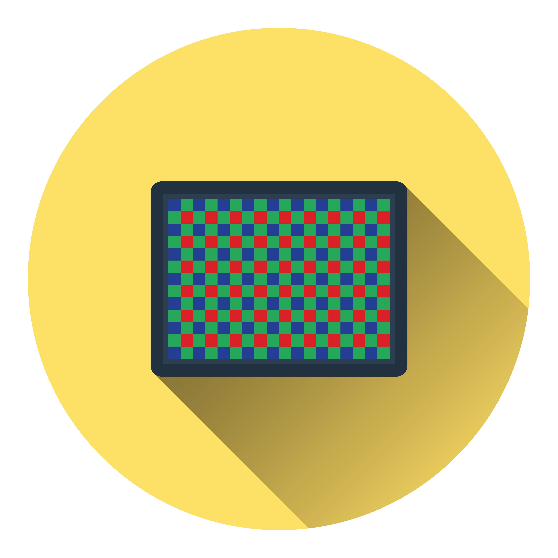
Table of contents
| Camera Model | MER2-2000-19U3M | MER2-2002-20U3M |
|---|---|---|
|
Sensor |
Sony IMX183 Rolling Shutter CMOS |
Onsemi AR2020 Rolling Shutter CMOS |
|
Resolution |
5496 x 3672 |
5120 x 3840 |
|
Total Pixels |
20.48 MP |
20 MP |
|
Pixel Size |
2.4 um |
1.4 um |
|
Optical Format |
1" |
1/1.8" |
|
SNR |
42.08 dB |
39.41 dB |
|
Standard Gain Range |
0 dB - 24 dB |
0 dB - 24 dB |
|
Gain (if using Remove Parameter Limits) |
0 dB - 27 dB |
0 dB - 50.6 dB |
|
Standard Exposure Time |
12us - 1s |
26us - 1s |
|
Exposure (if using Remove Parameter Limits) |
12us - 15s |
26us - 15s |
|
Pixel Bit Depth |
8-bit, 12-bit |
8-bit, 12-bit |
Influence of Gain, Exposure and Digital Shift ON IMX183 VS AR2020
Gain, exposure, and digital shift are key features that contribute to a camera's ability to capture light and influence the brightness and quality of images, especially in varying light conditions.
Light Sensitivity Tests IMX183 vs AR2020
Baseline Test of IMX183 vs AR2020
Set gain to 0dB. This provides a baseline with no additional noise from amplification.
To establish a fundamental measure of native light sensitivity, both cameras were tested at zero gain (0 dB). Exposure times were incrementally increased from 40 ms to 50 ms, and digital shift (the sensor’s internal capability to amplify the digital output) was applied progressively to the maximum allowed by each model.
To access the image results of the light sensitivity tests, fill in the form below that leads to our download page.
- At 40 ms exposure with no gain, the images from both sensors appeared relatively dark, with limited visibility of the test chart details.
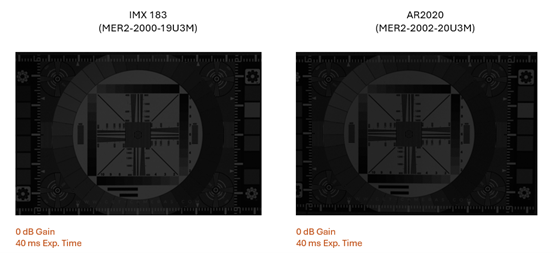
- When the exposure was increased to 50 ms and the maximum digital shift was applied, the Sony IMX183 sensor produced slightly brighter and higher contrast images compared to the Onsemi AR2020 sensor under the same conditions.
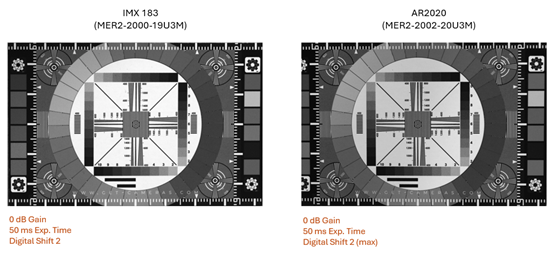
- The IMX183 sensor shows overexposure upon providing aggressive digital shifting and longer exposure.
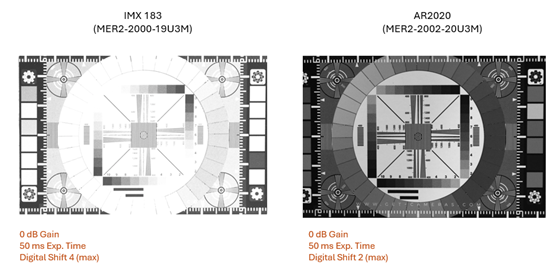
Digital Gain Test of IMX183 vs AR2020
In the next phase, both sensors were tested at maximum analog gain (24 dB) with a fixed exposure time of 10 ms.
As the analog gain increases from 12 dB to 24 dB, both cameras show a clear increase in image brightness at each gain step. The details of the test chart gradually become more visible in both cameras.
- 12 dB Gain:
At this lower gain level, both sensors produced relatively dark images, with only faint details of the test chart visible. The OnSemi AR2020 appeared slightly darker than the Sony IMX183 at this stage.
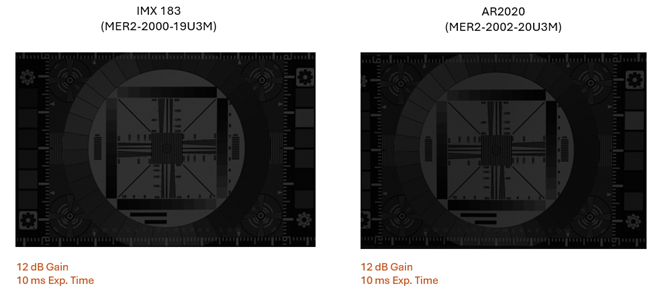
- 18 dB Gain:
Increasing the gain to 18 dB resulted in an improvement in brightness for both sensors, particularly in the lighter areas of the images, making the chart details more visible. The Sony IMX183 showed a slight advantage in overall brightness. However, noise became more noticeable in the darker regions of both images.
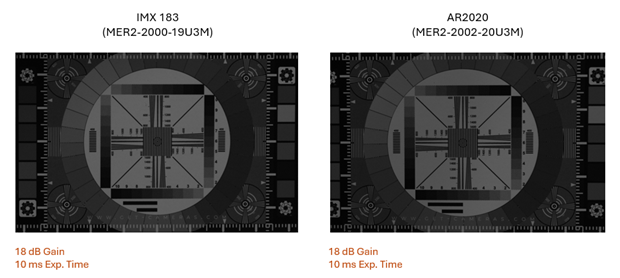
- 24 dB Gain (Maximum):
Both cameras reach their brightest images with maximum detail visibility. The IMX183 keeps a marginally higher contrast. However, noise and graininess significantly increase, reducing fine detail clarity in both sensors.
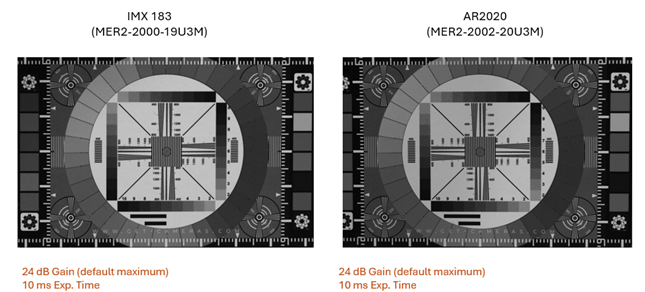
Digital Shift Test of IMX183 vs AR2020
Here, both industrial cameras are set at their default maximum gain (24 dB), varying both exposure time and digital shift values.
- Maximum Gain + Initial Digital Shift:
At 10 ms exposure with a minimal digital shift (shift 1), the Sony IMX183 delivers higher brightness and contrast. The test chart details are well visible on IMX183 images, whereas the OnSemi AR2020 images appear moderately visible but less bright.
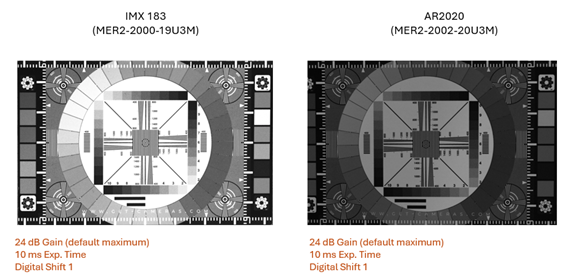
- Maximum Gain + Maximum Digital Shift:
At the same exposure time but with maximum digital shift applied (shift 4 for IMX183, shift 2 for AR2020), the IMX183 images become extremely bright, showing full overexposure. In contrast, the AR2020 remains balanced with good detail and contrast.
This suggests that while IMX183’s wider range of digital shifts allows more aggressive signal amplification, it comes with the risk of overexposure and potential loss of dynamic range. To overcome this, reducing exposure time can help retain image detail.
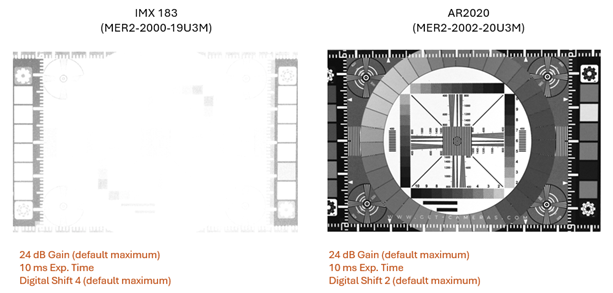
- Low Exposure + Maximum Digital Shift:
At very short exposure time (3 ms), combined with maximum gain and digital shift, both sensors recover brightness and chart details well. However, the IMX183 again tends to be overexposed compared to the AR2020, which shows the tones better. The IMX183 shifts toward lighter mid-tones.
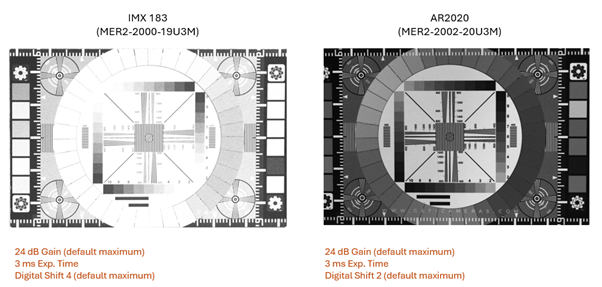
- Low Exposure + Equal Digital Shift:
When both cameras are set to the same digital shift (shift 2) at low exposure and maximum gain, their brightness levels become nearly equal. Noise remains noticeable in both sensors under these conditions.
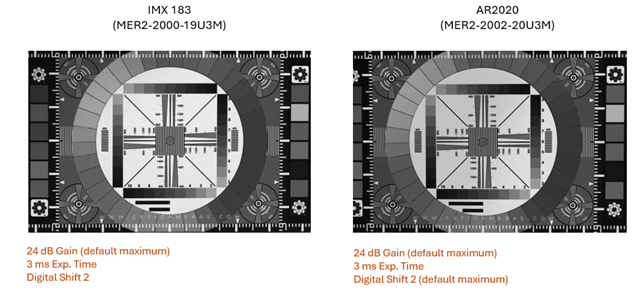
Expanding Gain Range: Utilizing Remove Parameter Limits for Maximum Sensitivity
Camera parameters typically have factory-defined limits to ensure optimal performance and high image quality. However, for specific applications, users may need to extend these ranges. The "Remove Parameter Limits" feature enables expanding the adjustable range of certain parameters beyond their factory defaults.
When this feature is applied, the maximum allowed gain is extended as follows:
- MER2-2000-19U3M: from 0 dB up to 27 dB
- MER2-2002-20U3M: from 0 dB up to 50.6 dB
To avoid overexposure at very high gain (50.6 dB), MER2-2002-20U3M exposure time is reduced from 10 ms to 0.5 ms
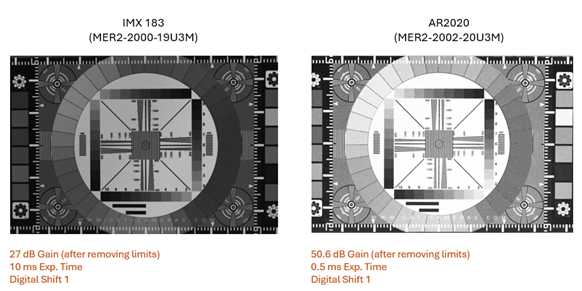
At these very high gain levels, noise becomes a critical factor affecting image quality. Images captured at 50.6 dB gain on the OnSemi AR2020 show visible grain and noise, which persist even when other settings are adjusted.
When comparing images between the Sony IMX183 and AR2020 at these extreme gain values, both appear somewhat similar; however, the IMX183 delivers a cleaner and brighter image overall.
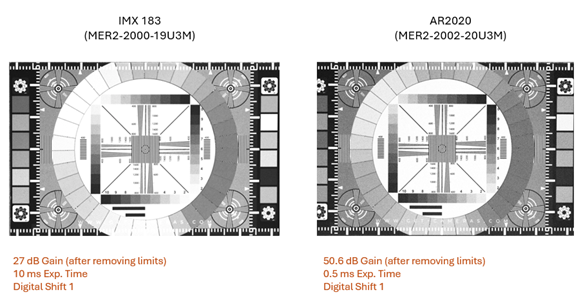
In the final test scenario, both sensors were pushed to their maximum gain, digital shift, and exposure settings. Under these conditions, the IMX183 images have severe overexposure, leading to a significant loss of detail in highlights and bright areas.
In contrast, although the AR2020 images have a lower exposure level, they still reveal details in the darker regions of the test chart.
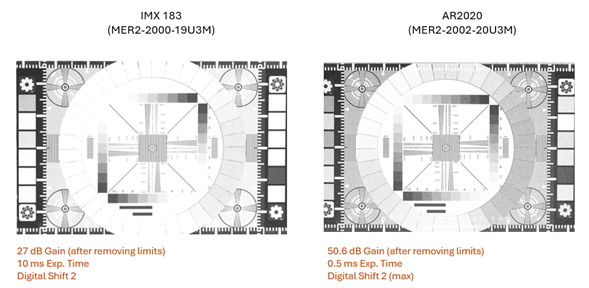
This highlights the importance of balancing settings: removing sensor limits allows extending sensitivity, but it also increases noise and can degrade image quality.
For the AR2020, this results in noticeable noise at extreme gain, and the IMX183 suffers from complete detail loss due to overexposure.
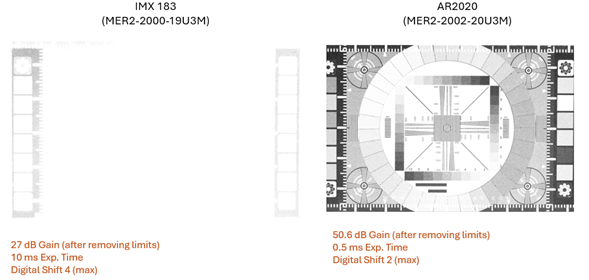
Conclusions of the light sensitivity of IMX183 vs AR2020
In comparison, the Sony IMX183 sensor offers advantages such as a larger pixel size (2.4 µm vs. 1.4 µm) and a slightly higher signal-to-noise ratio (42.08 dB vs. 39.41 dB), resulting in better per-pixel light sensitivity and cleaner images. The Onsemi AR2020, however, provides a much higher maximum configurable gain, which can make it more flexible in extreme low-light conditions where signal amplification is required, even if additional noise is introduced.
Overall, both sensors demonstrate strong capabilities with only marginal differences in image quality under standard conditions. The IMX183 may provide slightly brighter and cleaner results due to its pixel size and SNR advantage, while the AR2020 stands out when higher gain settings are essential. The optimal choice ultimately depends on the exact requirements of your low-light imaging application.
Want to learn more about these cameras or explore our full range of imaging solutions? Fill out the form below, and one of our specialists will get back to you as soon as possible. We’re here to help you find the best solution for your imaging needs.
















































